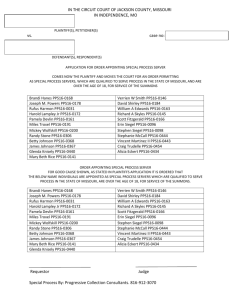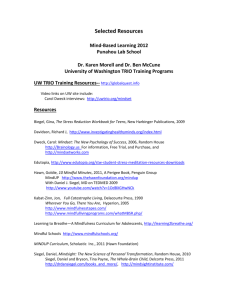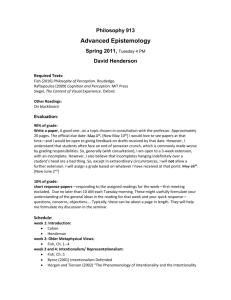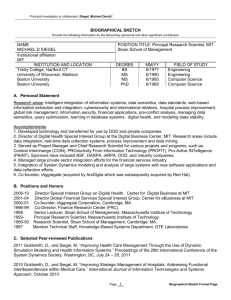Names: - icess
advertisement
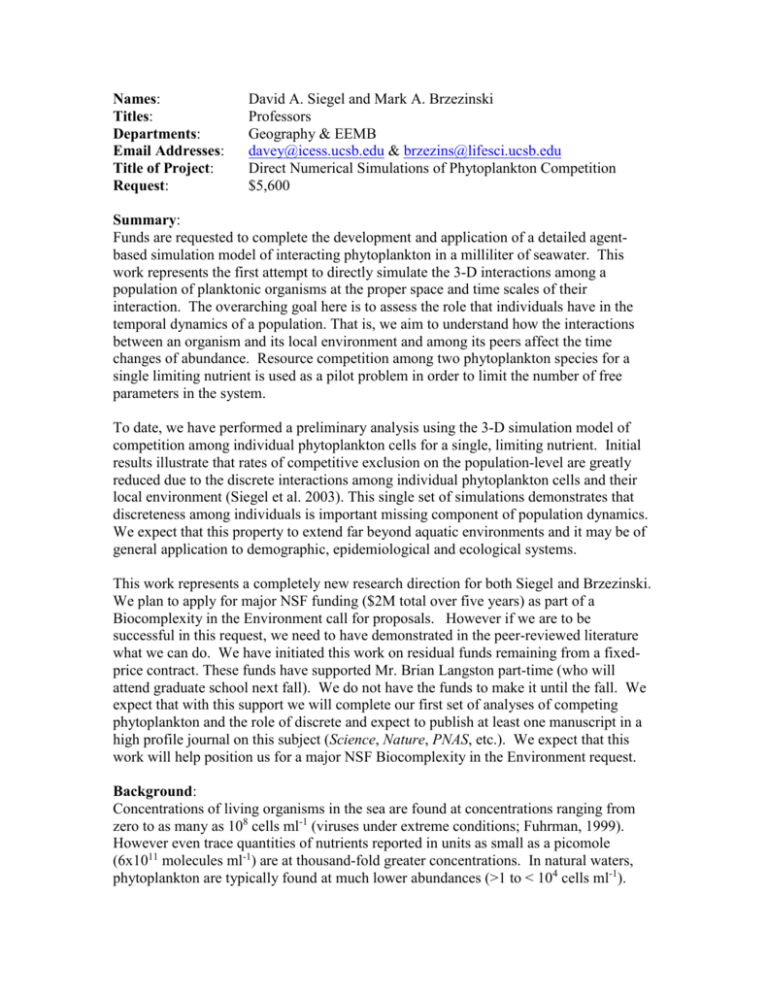
Names: Titles: Departments: Email Addresses: Title of Project: Request: David A. Siegel and Mark A. Brzezinski Professors Geography & EEMB davey@icess.ucsb.edu & brzezins@lifesci.ucsb.edu Direct Numerical Simulations of Phytoplankton Competition $5,600 Summary: Funds are requested to complete the development and application of a detailed agentbased simulation model of interacting phytoplankton in a milliliter of seawater. This work represents the first attempt to directly simulate the 3-D interactions among a population of planktonic organisms at the proper space and time scales of their interaction. The overarching goal here is to assess the role that individuals have in the temporal dynamics of a population. That is, we aim to understand how the interactions between an organism and its local environment and among its peers affect the time changes of abundance. Resource competition among two phytoplankton species for a single limiting nutrient is used as a pilot problem in order to limit the number of free parameters in the system. To date, we have performed a preliminary analysis using the 3-D simulation model of competition among individual phytoplankton cells for a single, limiting nutrient. Initial results illustrate that rates of competitive exclusion on the population-level are greatly reduced due to the discrete interactions among individual phytoplankton cells and their local environment (Siegel et al. 2003). This single set of simulations demonstrates that discreteness among individuals is important missing component of population dynamics. We expect that this property to extend far beyond aquatic environments and it may be of general application to demographic, epidemiological and ecological systems. This work represents a completely new research direction for both Siegel and Brzezinski. We plan to apply for major NSF funding ($2M total over five years) as part of a Biocomplexity in the Environment call for proposals. However if we are to be successful in this request, we need to have demonstrated in the peer-reviewed literature what we can do. We have initiated this work on residual funds remaining from a fixedprice contract. These funds have supported Mr. Brian Langston part-time (who will attend graduate school next fall). We do not have the funds to make it until the fall. We expect that with this support we will complete our first set of analyses of competing phytoplankton and the role of discrete and expect to publish at least one manuscript in a high profile journal on this subject (Science, Nature, PNAS, etc.). We expect that this work will help position us for a major NSF Biocomplexity in the Environment request. Background: Concentrations of living organisms in the sea are found at concentrations ranging from zero to as many as 108 cells ml-1 (viruses under extreme conditions; Fuhrman, 1999). However even trace quantities of nutrients reported in units as small as a picomole (6x1011 molecules ml-1) are at thousand-fold greater concentrations. In natural waters, phytoplankton are typically found at much lower abundances (>1 to < 104 cells ml-1). Simple scaling analyses show that phytoplankton distributions will be discrete whereas the nutrient fields which they utilize are continuous and that this discreteness should have an important role on population-level dynamics (Siegel, 1998). In particular, discreteness will be important for To test these hypotheses we have developed a Technical Description: The model simulates interactions among a few to 1000's of individual organisms for realistic space and time scales within a cubic centimeter of water. Individual cells uptake nutrients based upon their local nutrient concentration and divide when their intracellular nutrient content is twice a minimum value. Washout (or death) is affected by randomly removing cells from the volume and the cell's nutrient content is added back to the dissolved pool. The perturbed nutrient distribution diffuses following Fickian theory. The discrete simulation results are indistinguishable from continuous models of competition when the nutrient field is uniform. Cells assimilate local nutrients Cells can move by sinking or Brownian motion Nutrients diffuse by Fick’s law Cells divide when their quotas are twice a minimum Daughter cells are located randomly Death occurs randomly Dead cell nutrients are recycled locally However, when the nutrient field is allowed to vary spatially, significant differences are found. These are apparent in visualizations of the simulated fields and in the trajectories of populations. The discrete simulation results are compared with scaling theory (Siegel, 1998; L&O, 43, 1133-1146) to illustrate when individual discreteness is important to the dynamics of microbial populations. SiO 4 S u A f Goals of This Request: http://www.nsf.gov/pubs/2002/nsf02167/nsf02167.htm References: Siegel, D.A., B. Langston and M.A. Brzezinski, 2003: Population dynamics of microbes in a discrete world: Direct Numerical Simulations of Phytoplankton Competition. Presented at the Annual Meeting of the American Society of Limnology and Oceanography, Salt Lake City UT, February 2003. (powerpoint file available at www.icess.ucsb.edu/~davey/MyTalks/PhytoDNS_ASLO2003_020403.ppt) Siegel, D.A., 1998: Resource competition in a discrete environment: Why are plankton distributions paradoxical? Limnology and Oceanography, 43, 1133-1146. 2000-2003 Publications for David A. Siegel: Behrenfeld, M.J., E. Marañon, D.A. Siegel and S.B. Hooker, 2002: Photoacclimation and nutrient-based model of light-saturated photosynthesis for quantifying oceanic primary production. Marine Ecology-Progress Series, 228, 103-117. Chomko, R.M., H.R. Gordon, S. Maritorena and D.A. Siegel, 2002: Simultaneous determination of oceanic and atmospheric parameters for ocean color imagery by spectral optimization: a validation. In press, Remote Sensing of the Environment. Dickey, T., S. Zedler, D. Frye, H. Jannasch, D. Manov, D. Sigurdson, J. D. McNeil, L. Dobeck, X. Yu, T. Gilboy, C. Bravo, S. C. Doney, D.A. Siegel and N. Nelson, 2001: Physical and biogeochemical variability from hours to years at the Bermuda Testbed Mooring: June 1994 - March 1998. Deep Sea Research, II, 48, 2105-2140. Maritorena, S., D.A. Siegel and A.R. Peterson, 2002: Optimal tuning of a semi-analytical model for global applications. Applied Optics-LP, 41, 2705-2714. Nelson, N.B., and D.A. Siegel, 2002: Chromophoric DOM in the Open Ocean. In: Biogeochemistry of Marine Dissolved Organic Matter, D.A. Hansell and C.A. Carlson, eds. p. 547-578, Academic Press, San Diego, CA. Nelson, N.B., N.R. Bates, D.A. Siegel and A.F. Michaels, 2001: Spatial variability of the CO2 sink in the Sargasso Sea. Deep Sea Research, II, 48, 1801-1821. Ohlmann, J.C., and D.A. Siegel, 2000: Ocean radiant heating: II., Parameterization and influence on sea surface temperature prediction. Journal of Physical Oceanography, 30, 1849-1865. Ohlmann, J.C., D.A. Siegel, and C. Mobley, 2000: Ocean radiant heating: I., Optical influences. Journal of Physical Oceanography, 30, 1833-1848. Shipe, R.F., U. Passow, M.A. Brzezinski, D.A. Siegel and A.L. Alldredge, 2002: Effects of the 1997-98 El Nino on seasonal variations in suspended and sinking particles in the Santa Barbara Basin. Progress in Oceanography, 54, 105-127. Siegel, D.A., M. Wang, S.Maritorena and W. Robinson, 2000: Atmospheric correction of satellite ocean color imagery: The black pixel assumption. Applied Optics, 39, 35822591. Siegel, DA. 2001: Oceanography - The Rossby rototiller. Nature, 409, 576-577. Siegel, D.A., D.M. Karl and A.F. Michaels, 2001: Interpretations of biogeochemical processes from the U.S. JGOFS Bermuda and Hawaii time series sites. Deep Sea Research, II, 48, 1403-1404. Siegel, D.A., N.B. Nelson, M.C. O'Brien, T.K. Westberry, J.R. Morrison, A.F. Michaels, E.A. Caporelli, J.C. Sorensen, S.A. Garver, E.A. Brody, J. Ubante and M.A. Hammer, 2001: The Bermuda BioOptics Project: Bio-optical modeling of primary production from space-sensible variables. Deep Sea Research, II, 48, 1865-1896. Siegel, D.A., S.C. Doney and J.A. Yoder, 2002: The spring bloom of phytoplankton in the North Atlantic Ocean and Sverdrup's critical depth hypothesis. Science, 296, 730733. Siegel, D.A., S. Maritorena, N. B. Nelson, D.A. Hansell and M. Lorenzi-Kayser, 2002: Global ocean distribution and dynamics of colored dissolved and detrital organic materials. Journal of Geophysical Research, 107, 3228, DOI: 10.1029/2001JC000965. Siegel, D.A., and R.A. Armstrong, 2002: Corrigendum to "Siegel, D.A, and W.G. Deuser, 1997: Trajectories of sinking particles in the Sargasso Sea: Modeling of statistical funnels above deep-ocean sediment traps. Deep-Sea Research, I , 44, 1,5191,541", Deep-Sea Research, Part I, 49, 1115-1116. Siegel, D.A., B. Kinlan, B. Gaylord and S.D. Gaines, 2003: Lagrangian descriptions of marine larval dispersion. In press Marine Ecology Progress Series. Sorensen, J.C., and D.A. Siegel, 2001: Variability and models of the effective quantum yield of carbon assimilation in the Sargasso Sea, Deep Sea Research, II, 48, 2005-2035. Toole, D.A., and D.A. Siegel, 2001: Modes and mechanisms of ocean color variability in the Santa Barbara Channel. Journal of Geophysical Research, 106, 26,985-27,000. Toole, D.A., D.A. Siegel, D.W. Menzies, M.J. Neumann and R.C. Smith, 2000: Remote sensing reflectance determinations in coastal environments: impact of instrumental characteristics and environmental variability. Applied Optics, 39, 456-469. Toole, D.A., D.J. Kieber, R.P. Kiene, D.A. Siegel and N.B. Nelson, 2003: Photolysis and the dimethylsulfide (DMS) summer paradox in the Sargasso Sea. In press Limnology and Oceanography. Westberry T.K., and D.A. Siegel, 2003: Phytoplankton natural fluorescence in the Sargasso Sea: Prediction of primary production and eddy induced nutrient fluxes. In press Deep-Sea Research, Part I. 2000-2003 Publications for Mark A. Brzezinski: Bidle, K. D., M. A. Brzezinski, R. A. Long, J. L. Jones, and F. Azam. in press. Diminished efficiency of the oceanic silica pump caused by bacterially-mediated silica dissolution. Limnol. Oceanogr. Brzezinski, M. A., M.-L. Dickson, D. M. Nelson, and R. Sambrotto. in press. Ratios of Si, C and N Uptake by Microplankton in the Southern Ocean. Deep Sea Research II. Brzezinski, M. A., J. L. Jones, K. Bidle, and F. Azam. 2002a. The Balance Between Silica Production and Silica Dissolution in the Sea. Insights from Monterey Bay, California Applied to the Global Data Set. Limnol. Oceanogr. in press. Brzezinski, M. A., D. M. Nelson, V. M. Franck, and D. E. Sigmon. 2001. Silicon dynamics within an intense open-ocean diatom bloom in the Pacific sector of the Southern Ocean. Deep-Sea Res. II 48: 3997-4018. Brzezinski, M. A., C. J. Pride, V. M. Franck, D. M. Sigman, J. L. Sarmiento, K. Matsumoto, N. Gruber, G. H. Rau, and K. H. Coale. 2002b. A switch from Si(OH)4 to NO3- depletion in the glacial Southern Ocean. Geophys. Res. Let. 29: 10.1029/2001GL014349. Buesseler, K. O., L. Ball, J. Andrews, J. K. Cochran, D. J. Hirschberg, M. P. Bacon, A. Fleer, and M. A. Brzezinski. 2001. Upper ocean export of particulate organic carbon and biogenic silica in the Southern Ocean along 170W. Deep-Sea Res. II 48: 42754297. De La Rocha, C. L., M. A. Brzezinski, and M. J. DeNiro. 2000a. A first look at the distribution of the stable isotopes of silicon in natural waters. Geochimica et Cosmochimica Acta 64: 2467-2477. De La Rocha, C. L., M. A. Brzezinski, D. A. Hutchins, and Y. Zhang. 2000b. Effects of iron and zinc efficiency on elemental composition and silica production of diatoms. Mar. Ecol. Prog. Ser. 195: 71-79. Franck, V. M., K. W. Bruland, D. A. Hutchins, and M. A. Brzezinski. 2002. Fe and Zn effects on silicic acid and nitrate uptake kinetics in three high-nutrient, low chlorophyll (HNLC) regions. Mar. Ecol. Prog. Ser. in press. Franck, V. M., M. A. Brzezinski, K. H. Coale, and D. M. Nelson. 2000. Iron and silicic acid concentrations regulate Si uptake north and south of the Polar Frontal Zone in the Pacific Sector of the Southern Ocean. Deep-Sea Res. II 47: 3315-3338. Martin-Jezequel, V., M. Hildebrand, and M. A. Brzezinski. 2000. Silicon metabolism in diatoms: Implications for growth. J. Phycol. 36: 821-840. Matsumoto, K., J. L. Sarmiento, and M. A. Brzezinski. 2001. Silicic acid 'leakage' from the Southern Ocean as a possible mechanism for explaining glacial atmospheric pCO2. Global Biogeochem. Cycles 2001GB001442. Nelson, D. M., R. F. Anderson, R. T. Barber, M. A. Brzezinski, K. O. Buesseler, Z. Chase, R. W. Collier, M.-L. Dickson, R. Francois, M. Hiscock, S. Honjo, J. Marra, W. R. Martin, R. N. Sambrotto, F. L. Sayles, and D. E. Sigman. 2002. Vertical budgets for organic carbon and biogenic silica in the Pacific sector of the Southern Ocean, 19961998. Deep Sea Research II 49: 1645-1673. Nelson, D. M., M. A. Brzezinski, D. E. Sigmon, and V. M. Franck. 2001. A seasonal progression of Si limitation in the Pacific sector of the Southern Ocean. Deep-Sea Res. II 48: 3973-3995. Passow, U., R. F. Shipe, A. Murray, D. K. Pak, M. A. Brzezinski, and A. L. Alldredge. 2001. The origin of transparent exopolymer particles (TEP) and their role in the sedimentation of particulate matter. Cont. Shelf. Res. 21: 327-346. Queguiner, B., and M. A. Brzezinski. 2002. Biogenic silica production rates and particulate organic matter distribution in the Atlantic sector of the Southern Ocean during austral spring 1992. Deep Sea Research II 49: 1765-1786. Ragueneau, O., P. Treguer, A. Leynaert, R. F. Anderson, M. A. Brzezinski, D. J. DeMaster, R. C. Dugdale, J. Dymond, G. Fischer, R. Francois, C. Heinze, E. MaierReimer, V. Martin-Jezequel, D. M. Nelson, and B. Queguiner. 2000. A review of the Si cycle in the modern ocean: recent progress and missing gaps in the application of biogenic opal as a peloproductivity proxy. Global and Planetary Change 26: 317-365. Shimizu, K., Y. Del Amo, M. A. Brzezinski, G. D. Stucky, and D. E. Morse. 2001. A novel fluorescent silica tracer for biological silicification studies. Chemistry and Biology 8: 1051-1060. Shipe, R. F., and M. A. Brzezinski. 2001. A time-series study of silica production and flux in an eastern boundary region: Santa Barbara Basin, California. Global Biogeochem. Cycles 15: 517-531. Shipe, R. F., U. Passow, M. A. Brzezinski, W. M. Graham, D. K. Pak, D. A. Siegel, and A. L. Alldredge. 2002. Effects of the 1997-1998 El Nino on seasonal variations in suspended and sinking particles in the Santa Barbara Basin. Progress. in. Oceanography. 54: 105-107. Sigmon, D. E., D. M. Nelson, and M. A. Brzezinski. 2002. The Si cycle in the Pacific sector of the Southern Ocean: Seasonal diatom production in the surface layer and export to the deep sea. Deep-Sea Res. II 49: 1747-1763
